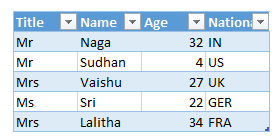Vba tables introduction in Excel
In Excel, a group of cells can be turned into a table, so as to manage the data easily.
An Excel table contains related data in a series of rows and columns that have been formatted as a table.
The data in Excel table is distinct and can be managed independently from data in other row and columns.
The Excel table was previous known as Excel List.
An Excel table has the following:
Header Row
Any Excel table will have the first row as header by default.
All the Headers will have a filter added to it so as to sort and filter data efficiently.

Banded Rows
The data rows are formatted with automatic banding or shading so as to distinguish alternate rows.
From the above table, it is seen that, alternate rows are shaded differently.
Calculated Column
A formula in cell in a column can be automatically applied to other cells in the same column.
This is synonymous to the autofill feature of excel.
Total Row
The Table can added with a "Total Row" at the bottom which provides access to summary functions such as AVG,Sum,TOT and so on.
Sizing handle
It is a small handle at the Right-bottom of the table.
It allows the user to drag the table to required size.
Adding new Rows
To add new rows to the table, the following has to be done.
select the last cell of the table at the right-bottom and press "TAB" key.
This will add a new row to the table.
An excel can hold more than one table in a sheet and eachof them can be managed independently.
Keeping data in a table offers a lot of advantages in handling the data, rather than storing in a plain format of rows and columns.
Important note: Excel table is a separate entity and is not same as a Datatable, which will be discussed in the coming chapters.